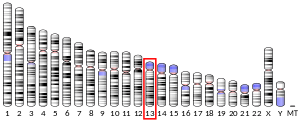ELF1
E74-like factor 1 (ets domain transcription factor) is a protein that in humans is encoded by the ELF1 gene.[5]
Function
This gene encodes an E26 transformation-specific related transcription factor. The encoded protein is primarily expressed in lymphoid cells and acts as both an enhancer and a repressor to regulate transcription of various genes. Alternative splicing results in multiple transcript variants.[5]
References
Further reading
- Xiang P, Lo C, Argiropoulos B, Lai CB, Rouhi A, Imren S, Jiang X, Mager D, Humphries RK (Sep 2010). "Identification of E74-like factor 1 (ELF1) as a transcriptional regulator of the Hox cofactor MEIS1". Experimental Hematology. 38 (9): 798–8, 808.e1–2. doi:10.1016/j.exphem.2010.06.006. PMC 3887005. PMID 20600580.
- Juang YT, Solomou EE, Rellahan B, Tsokos GC (Mar 2002). "Phosphorylation and O-linked glycosylation of Elf-1 leads to its translocation to the nucleus and binding to the promoter of the TCR zeta-chain". Journal of Immunology. 168 (6): 2865–71. doi:10.4049/jimmunol.168.6.2865. PMID 11884456.
- Mao S, Frank RC, Zhang J, Miyazaki Y, Nimer SD (May 1999). "Functional and physical interactions between AML1 proteins and an ETS protein, MEF: implications for the pathogenesis of t(8;21)-positive leukemias". Molecular and Cellular Biology. 19 (5): 3635–44. doi:10.1128/mcb.19.5.3635. PMC 84165. PMID 10207087.
- Nishiyama C, Takahashi K, Nishiyama M, Okumura K, Ra C, Ohtake Y, Yokota T (Dec 2000). "Splice isoforms of transcription factor Elf-1 affecting its regulatory function in transcription-molecular cloning of rat Elf-1". Bioscience, Biotechnology, and Biochemistry. 64 (12): 2601–7. doi:10.1271/bbb.64.2601. PMID 11210123.
- Thompson CB, Wang CY, Ho IC, Bohjanen PR, Petryniak B, June CH, Miesfeldt S, Zhang L, Nabel GJ, Karpinski B (Mar 1992). "cis-acting sequences required for inducible interleukin-2 enhancer function bind a novel Ets-related protein, Elf-1". Molecular and Cellular Biology. 12 (3): 1043–53. doi:10.1128/mcb.12.3.1043. PMC 369536. PMID 1545787.
- Tsokos GC, Nambiar MP, Juang YT (Apr 2003). "Activation of the Ets transcription factor Elf-1 requires phosphorylation and glycosylation: defective expression of activated Elf-1 is involved in the decreased TCR zeta chain gene expression in patients with systemic lupus erythematosus". Annals of the New York Academy of Sciences. 987: 240–5. doi:10.1111/j.1749-6632.2003.tb06054.x. PMID 12727645.
- Gunther M, Laithier M, Brison O (Jul 2000). "A set of proteins interacting with transcription factor Sp1 identified in a two-hybrid screening". Molecular and Cellular Biochemistry. 210 (1–2): 131–42. doi:10.1023/A:1007177623283. PMID 10976766.
- Yang W, Tang H, Zhang Y, Tang X, Zhang J, Sun L, et al. (Jan 2013). "Meta-analysis followed by replication identifies loci in or near CDKN1B, TET3, CD80, DRAM1, and ARID5B as associated with systemic lupus erythematosus in Asians". American Journal of Human Genetics. 92 (1): 41–51. doi:10.1016/j.ajhg.2012.11.018. PMC 3542470. PMID 23273568.
- Bassuk AG, Anandappa RT, Leiden JM (May 1997). "Physical interactions between Ets and NF-kappaB/NFAT proteins play an important role in their cooperative activation of the human immunodeficiency virus enhancer in T cells". Journal of Virology. 71 (5): 3563–73. PMC 191503. PMID 9094628.
This article incorporates text from the United States National Library of Medicine, which is in the public domain.
This article is issued from
Wikipedia.
The text is licensed under Creative Commons - Attribution - Sharealike.
Additional terms may apply for the media files.



